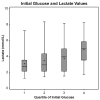Prevalence and significance of lactic acidosis in diabetic ketoacidosis
- PMID: 22033060
- PMCID: PMC3610316
- DOI: 10.1016/j.jcrc.2011.07.071
Prevalence and significance of lactic acidosis in diabetic ketoacidosis
Abstract
Purpose: The prevalence and clinical significance of lactic acidosis in diabetic ketoacidosis (DKA) are understudied. The objective of this study was to determine the prevalence of lactic acidosis in DKA and its association with intensive care unit (ICU) length of stay (LOS) and mortality.
Methods: Retrospective, observational study of patients with DKA presenting to the emergency department of an urban tertiary care hospital between January 2004 and June 2008.
Results: Sixty-eight patients with DKA who presented to the emergency department were included in the analysis. Of 68 patients, 46 (68%) had lactic acidosis (lactate, >2.5 mmol/L), and 27 (40%) of 68 had a high lactate (>4 mmol/L). The median lactate was 3.5 mmol/L (interquartile range, 3.32-4.12). There was no association between lactate and ICU LOS in a multivariable model controlling for Acute Physiology and Chronic Health Evaluation II, glucose, and creatinine. Lactate correlated negatively with blood pressure (r = -0.44; P < .001) and positively with glucose (r = 0.34; P = .004).
Conclusions: Lactic acidosis is more common in DKA than traditionally appreciated and is not associated with increased ICU LOS or mortality. The positive correlation of lactate with glucose raises the possibility that lactic acidosis in DKA may be due not only to hypoperfusion but also to altered glucose metabolism.
Copyright © 2012 Elsevier Inc. All rights reserved.
Conflict of interest statement
Conflicts of Interest: The authors have no conflicts of interest to declare.
Figures




References
-
- Kitabchi AE, Umpierrez GE, Murphy MB, et al. Hyperglycemic crises in adult patients with diabetes: a consensus statement from the American Diabetes Association. Diabetes Care. 2006;29(12):2739–48. - PubMed
-
- Kitabchi AE, Umpierrez GE, Murphy MB, et al. Management of hyperglycemic crises in patients with diabetes. Diabetes Care. 2001;24(1):131–53. - PubMed
-
- Wilson JF. In clinic. Diabetic ketoacidosis. Ann Intern Med. 2010;152(1) - PubMed
-
- Abramson D, Scalea TM, Hitchcock R, et al. Lactate clearance and survival following injury. J Trauma. 1993;35(4):584–8. [discussion 588–9] - PubMed
-
- Bakker J, Gris P, Coffernils M, et al. Serial blood lactate levels can predict the development of multiple organ failure following septic shock. Am J Surg. 1996;171(2):221–6. - PubMed

